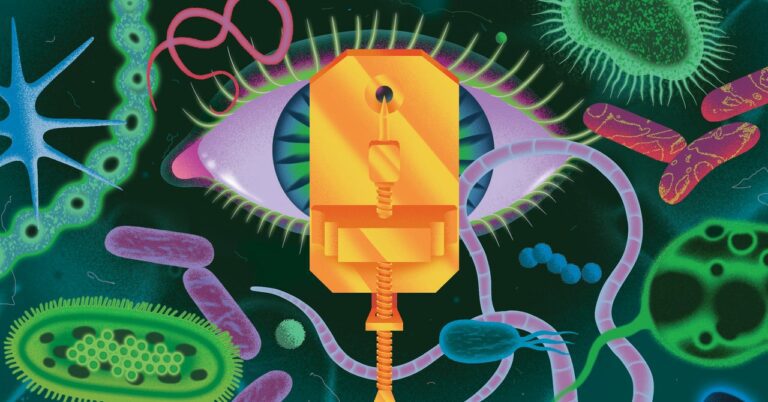
[ad_1]
“It almost seems as if Van Leeuwenhoek knew that a new microworld was to unfold,” Cocquyt told me. One of his scientific rivals, Johannes Hudde, later said, “isn’t it surprising that we never had the creativity to use these ball lenses to observe little things against the daylight, and that an uneducated and ignorant man such as Van Leeuwenhoek had to be the one to teach this to us.”
Van Leeuwenhoek was the fifth son of a basket maker, born in the Delft—a small port city in South Holland known for its picturesque waterways, pottery, and beer. At 16 he departed for an apprenticeship as a dry goods seller in Amsterdam, but six years later he returned home, married the daughter of a well-regarded local brewer, and purchased his own fabric shop.
He spent his twenties growing a successful business but suffered immense personal tragedy. Of the five children he and his wife Barbara had in their 12 years of marriage, four died in infancy; Barbara would soon follow. Few biographical details have survived from his first decade back in Delft, but he held a number of odd jobs in addition to running his draper shop, including working as chief custodian of the local courthouse. A stint as town surveyor offers one clue to Van Leeuwenhoek’s budding scientific potential: proof he had learned geometry.
His obsession with magnifying lenses began sometime in his mid-thirties. How he came upon it isn’t known. His writings never touch on its origins. Perhaps, as many have speculated, he started using lenses to inspect the quality of his cloth. Or maybe he got caught up in the public mania for microscopes following the publication of Hooke’s Micrographia. Van Leeuwenhoek never mentions the book in any of his letters, but the timing aligns, and he clearly read it: Some of his experiments replicate Hooke’s too closely to be a coincidence. But regardless of how Van Leeuwenhoek got into microscopy, by 1668 he had begun pursuing it with an unusual tenacity. While traveling in England that year, he saw the white cliffs of Dover and felt compelled to examine their chalky slopes beneath his lens: “I observed that chalk consisteth of very small transparent particles; and these transparent particles lying one upon another, is, methinks now, the reason why chalk is white.”
By 1673, though still operating in complete obscurity, he was already making the world’s most powerful lenses. His obscurity might very well have continued, and the momentous discovery of microorganisms might well have served only to satisfy this curious individual’s psychological compulsion, were it not for a Delft physician named Renier de Graaf.
De Graaf had come to some renown through his experiments using dyes to determine organ function, and in 1673 he introduced Van Leeuwenhoek to the Royal Society with a note calling him a “most ingenious person … who has devised microscopes which far surpass those which we have hitherto seen.” Following that preamble, Van Leeuwenhoek described the body parts of a louse in his precise-yet-meandering writing style that is, as one biographer notes, “distinguished with a certain business formality, but an almost total lack of coherence.” Over the next year, he sent five more letters to the Royal Society conveying interesting but not particularly controversial observations about the globules in milk and the structure of his fingernails. Then, on September 7, 1674, he sent the letter reporting his shocking discovery: Within an otherwise unremarkable drop of pond water he had seen “glittering” creatures a thousand times smaller than any animal he had previously observed.
The Society’s secretary, Henry Oldenburg, replied to Van Leeuwenhoek with understandable restraint: “This phenomenon, and some of the following ones seeming to be very extraordinary, the author hath been desired to acquaint us with his method of observing, that others may confirm such observations as these.” Van Leeuwenhoek quickly responded, providing eyewitness accounts of a few local dignitaries who had looked through his lenses—but refused to disclose the secrets of his techniques. “My method for seeing the very smallest animalcules and minute eels, I do not impart to others; nor how to see very many animalcules at one time. That I keep for myself alone,” he wrote. Even when Hooke himself, who learned to speak Dutch just so he could communicate with Van Leeuwenhoek without translation, specifically asked how he made his observations, the stubborn scientist refused for reasons that were, as Hooke later wrote, “best known to himself.”
[ad_2]